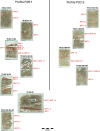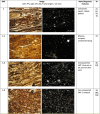Understanding late medieval farming practices: an interdisciplinary study on byre remains from the historical centre of Brussels (Belgium)
- PMID: 40585909
- PMCID: PMC12198283
- DOI: 10.1007/s12520-025-02248-w
Understanding late medieval farming practices: an interdisciplinary study on byre remains from the historical centre of Brussels (Belgium)
Abstract
During the preventive archaeological excavation in the cellar of the site of petite Rue des Bouchers in the historical centre of Brussels (Belgium), the waterlogged remains of a thirteenth century AD sunken byre (potstal) were discovered. The exceptional preservation instigated a multiproxy approach, including micro-archaeology, micromorphology, phytolith and endoparasite egg analysis on thin sections, palynology and the study of plant macroremains on the fill of the structure. Beyond permitting to detail the content and the multiple origins of the fill (including excremental waste and urines, fodder and bedding material, plaggen and/or soil sods, household and construction waste), this study also provides detailed insights into the foddering customs, hygienic conditions within the stable, and the health status of the animals kept. On a more general scale this study documented late medieval farming practices in Brussels, more specifically the need to collect substantial amounts of manure to add as fertilizer onto the cultivated poor sandy soils.
Supplementary information: The online version contains supplementary material available at 10.1007/s12520-025-02248-w.
Keywords: Archaeobotany; Manure; Medieval; Micromorphology; Palaeoparasitology; Stable.
© The Author(s) 2025.
Conflict of interest statement
Competing interestsThe authors declare no competing interests.
Figures












References
-
- Albert RM, Shahack-Gross R, Cabanes D, Gilboa A, Lev-Yadun S, Portillo M, Sharon I, Boaretto E, Weiner S (2008) Phytolith-rich layers from the Late Bronze and Iron Ages at Tel Dor (Israel): mode of formation and archaeological significance. J Archaeol Sci 35:57–75. 10.1016/j.jas.2007.02.015
-
- Alonso-Eguiluz M, Albert RM, Verges M, Fernandez-Eraso J (2024) New insights into shepherds’ activities: Multi-proxy approach applied to fumier deposits from the north of Iberian Peninsula. Quatern Int 683–684:145–161. 10.1016/j.quaint.2023.06.012
-
- Alonso-Eguiluz M, Lo Russo S, Vrydaghs L, Tribel P, Bontempi G, Schenkel A, Celis D, Nys K, Devos Y (2025) Two methods, two views: Integrating phytoliths in thin sections and bulk samples on the urban Dark Earths from the DIVA-site (Antwerp, Belgium). PLoS ONE 20:e0320122. 10.1371/journal.pone.0320122 - PMC - PubMed
-
- Antolín F, Steiner B, Vach W, Jacomet S (2015) What is a litre of sediment? Testing volume measurement techniques for wet sediment and their implications in archaeobotanical analyses at the Late Neolithic lake-dwelling site of Parkhaus Opéra (Zürich, Switzerland). J Archaeol Sci 61:36–44. 10.1016/j.jas.2015.04.019
-
- Arpin TL, Mallol C, Goldberg P (2002) A New Method of Analyzing and Documenting Micromorphological Thin Sections Using Flatbed Scanners: Applications in Geoarchaeological Studies. Geoarchaeology 17(3):305–313. 10.1002/gea.10014
LinkOut - more resources
Full Text Sources
